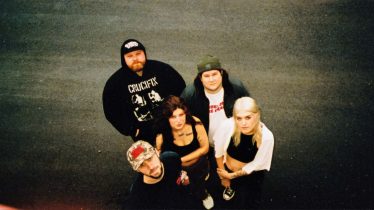These 15 punk albums from 1985 are the roots of alternative rock
The year is 1985: Punk’s now 10 years old and changing again. Hardcore was now a formula: 1. Pick a seemingly random number of initials for your name (Say, SRI – Social Reagan Injustice); 2. Play at light speed. 3. Sing about how you hate Reagan and nuclear war. 4. Shave your head. Like rock music itself, punk was mutating into several splinter styles, taking on some distinctly un-punk musical colors and learning a thing or two about songcraft. These are some of the best punk albums from 1985.
Punk elements assimilated into the mainstream, as Madonna brought the fashion sense into dance clubs, hardcore jokesters Beastie Boys infused hip-hop with attitude and roots rock injected more traditional musical shapes with fresh energy. Conversely, as certain hardcore bands followed Black Flag‘s lead (going metal as they learned to play their instruments), other metal bands sped up to hardcore specs ( Metallica, Slayer). The year’s best bands now figured out how to meld punk with some artsier notions, noise and classic pop songwriting. These 15 punk albums from 1985 feature some of the signposts to an alternative and grunge future.
Read more: 18 hardcore and metalcore bands you probably forgot from the 2000s
The Jesus And Mary Chain – Psychocandy
Across 1984, Scotland’s the Jesus And Mary Chain released single after single of perfect pop songs. Imagine Phil Spector producing a Ramones/Beach Boys/Velvet Underground jam session destroyed by guitar feedback so excessive, it sonically resembled a cross between your mother’s vacuum cleaner breaking down and your old junior high school PA system running amok at assembly. A surly awkwardness exacerbated by heavy drug use and gigs that became riots as they walked off nonchalantly after 10 minutes got ’em headlines, declaring them the “new Sex Pistols.” “Fuck you” never sounded so tuneful, catchy and joyous as on Psychocandy.
Sonic Youth – Bad Moon Rising
Named after John Fogerty‘s 1969 rumination on Nixon, Sonic Youth‘s second LP is a treatise on the ’60s end. (“Manson, Altamont and the flower power movement turning dark,” as then-drummer Bob Bert put it.) Their 1983 debut saw them utilizing cheap guitars tuned to anything but A440, struck by screwdrivers onto drumsticks jammed into the strings to simply make a racket. That racket now created real songs, with real tunes, sometimes chiming like bells. Bad Moon Rising peaks with “Death Valley ’69,” a caterwauling Lydia Lunch collaboration set atop an ace Stooges impersonation.
Hüsker Dü – Flip Your Wig
Hüsker Dü were outgrowing hardcore. Bob Mould and Grant Hart both increasingly applied loud, aggressive guitar rock to straight pop songs. Earlier in ’85, New Day Rising tracks such as Mould’s “I Apologize” and Hart’s “The Girl Who Lives On Heaven Hill” jangled as much as they slammed. Flip Your Wig featured cleanly recorded speed-pop nuggets. The title track and the Mould-generated single “Makes No Sense At All” lacked no guitar aggression but gained in melodicism. The result was SST’s biggest seller and a Warner record contract.
The Replacements – Tim
Hüsker Dü‘s crosstown rivals had already arrived at Warner, inking to subsidiary Sire Records, home of the Ramones, Dead Boys and other early U.S. punk paragons. Sire was wise enough to team the Replacements with original Ramones drummer/producer Tommy Erdelyi, in the same studio as Flip Your Wig (They also shared engineer Steve Fjelstad). The results on Tim weren’t far off from their Twin/Tone output, only somewhat slicker, without sacrificing their boozy swagger. Paul Westerberg‘s songwriting had grown exponentially, peaking in the anthemic “Bastards Of Young,” subject of one of the most fuck-you MTV videos ever lensed.
Descendents – I Don’t Want To Grow Up
Bill Stevenson had intended to drum for both his new band (Black Flag) and his old one: Descendents, Manhattan Beach’s answer to Buzzcocks. But the taste for touring that road dogs Black Flag gave him clashed with his bandmates. After reconvening with college-graduate singer Milo Aukerman, moving his replacement Ray Cooper to guitar, they cut Stevenson’s best batch of speed-pop tunes to date. Bowing to the new trend of ditching Spot in favor of producing themselves, gems such as “Silly Girl” and “Can’t Go Back” nicely complement any song from Flip Your Wig.
Rites Of Spring – Rites Of Spring
Behold the birth of emo with Rites Of Spring’s self-titled album. Guitarist Eddie Janney had driven hardcore crew the Faith. Singer/guitarist Guy Picciotto, drummer Brendan Canty and bassist Mike Fellows were only slightly less seasoned. But they took the gut D.C. sound, with all its drive and aggression, and rendered it as melodically and compositionally expansive as any of 1985’s best punk. And while Rites also shared the personal lyrical themes of other 1985 luminaries, they especially stood out against other D.C. bands. They inadvertently (and reluctantly) sired a movement before breaking up. Not long after, Picciotto and Canty were recruited for Fugazi.
Naked Raygun – All Rise
Naked Raygun singer Jeff Pezzati had tooled around Chicago with an evolving lineup since 1980. Their 1985 debut full-length, Throb Throb, introduced John Haggerty‘s wall of guitars. Producer Iain Burgess captured a punk band of extraordinary power and melodic invention, enamored with occasional jazz grooves and pure shout-along nonsense that felt good. Their second LP, All Rise, introduced new drummer Eric Spicer and bassist Pierre Kezdy. Burgess rendered Haggerty’s already-enormous guitar sound into a towering skyscraper that spread as wide as the Great Wall Of China. With anthems such as “Home Of The Brave,” Naked Raygun defined the Midwestern punk sound for years.
Government Issue – The Fun Just Never Ends
Starting with 1984’s Joyride, D.C. stalwarts Government Issue were defined by Tom Lyle‘s 1,500-pound guitars and John Stabb‘s rounded, eccentric yelp. Increasingly, “hardcore” felt like an inaccurate descriptor. True, their fourth studio LP was only nine songs, and cuts such as “Mad At Myself” traveled at that old-time locomotion. But “Vanity Fare” was old-school heavy rock, while the rest could have been outtakes from mid-period Damned LPs with hints of psychedelia and garage rock swimming amid Lyle’s 15-feet-tall chords. This is GI‘s first masterpiece.
Killing Joke – Night Time
From 1979 on, Killing Joke had released four LPs’ worth of post-punk, owing much to non-post-punk and heavy metal of the purest ore (especially in Geordie Walker‘s vicious guitar tone). This meant you saw Killing Joke sharing punk-house record shelf space alongside Black Flag and the Sex Pistols. Night Time incorporates more of a pop sensibility and dance-club grooves in the overall sonic picture, explaining its broader commercial appeal. Nirvana‘s Kurt Cobain certainly knew the anthemic “Eighties” had a killer guitar hook. Play it back to back with “Come As You Are” some time for an “aha!” moment. One of the best punk albums of 1985 ended up influencing the biggest punk albums of 1992…
Hoodoo Gurus – Mars Needs Guitars!
Sydney, Australia’s Hoodoo Gurus featured alumni of early Down Under punk sensations such as the Victims and the Scientists. Their 1984 debut, Stoneage Romeos, brimmed with ’60s pop melodies, raunchy punk guitars and a fondness for American trash culture. It also featured one of the greatest pop singles ever, “I Want You Back.” Mars Needs Guitars! continued in the same vein, opening with the melancholy “Bittersweet” and continuing with the Gary Glitter-ish glam stomper “Poison Pen.” Singer Dave Faulkner‘s arch lyrical snarl ruled, as his and Brad Shepherd‘s guitars alternately jangled and barked.
Dead Kennedys – Frankenchrist
American punk’s great political conscience tired of hardcore. Dead Kennedys’ third LP, Frankenchrist, produced by singer Jello Biafra (after guitarist East Bay Ray helmed 1982’s Plastic Surgery Disasters), saw tempos downshift, with only a few thrashy exceptions (“Hellnation”). Only “Jock-O-Rama” recognizably resembled the classic Dead Kennedys sound. Instead, the band explored the psychedelic underpinnings that swam through their music without truly abandoning punk. After an incensed parent saw the inclusion of H.R. Giger‘s explicit painting Penis Landscape as a poster, a resultant failed obscenity lawsuit strained the DKs.
Minutemen – 3-Way Tie (For Last)
The previous Minutemen release (the six-song EP Project: Mersh) spoofed then-current pop music with a clean, radio-ready production (including synthesizer). The San Pedro trio must’ve enjoyed the clearer sonics, continuing to use them for a diverse set of tunes, such as the swinging “The Big Stick” or the crushing rocker “Political Nightmare.” There’s also a sheath of covers ranging from Blue Oyster Cult to Creedence Clearwater Revival to early L.A. punks Urinals. Shortly after 3-Way‘s release, singer/guitarist D. Boon was killed in a van crash at age 27. The album became Boon’s epitaph, and Minutemen were no more. One of the best punk of albums of 1985, coupled with great sorrow.
The Fall – This Nation’s Saving Grace
Centered around poet Mark E. Smith, the Fall began in the thick of Manchester’s fertile late ’70s punk scene alongside Buzzcocks and Joy Division. They went through musicians like Tony Montana went through coke, mostly due to Smith’s caustic personality. Along the way, they perfected an absurdist reduction of rock ’n’ roll too raw for post-punk or art rock. His marriage to guitarist Brix Smith, however, brought somewhat of a pop ethic to the band. This Nation’s Saving Grace, the eighth Fall LP, might be their most accessible, despite the relentlessness of tracks such as “Barmy,” “Spoilt Victorian Child” and “L.A.”
Thee Mighty Caesars – Beware The Ides Of March
British garage-punk polymath Billy Childish‘s previous band, Thee Milkshakes, ground to a halt in 1984 on their ninth LP, Thee Knights Of Trashe. Childish convened immediately with bassist John Agnew and drummer Graham Day of the similar-minded Prisoners to form Thee Mighty Caesars. Still funneling early U.K. beat group sounds through the rawness of first-wave Britpunks, the Caesars were cruder than Thee Milkshakes, with Childish now front and center. Self-penned two-chord bashers such as “It Ain’t No Sin” and “This Man’s Determined” on Beware The Ides Of March were powered by an explicit, personal lyrics that shared DNA with Childish’s raw, Charles Bukowski-esque poetry. Definitely one of the more obscure punk albums of 1985.
Dinosaur Jr. – Dinosaur
Evolving out of Westfield, Massachusetts, hardcore outfit Deep Wound, Dinosaur (as they were known initially) saw drummer J Mascis switch to fuzz-drenched guitar and vocals, with bandmate Lou Barlow remaining on bass. They’d become enamored with heavier, slower, emotional music that bordered on the psychedelic, a la Black Sabbath, the Dream Syndicate and Neil Young‘s electric side. Recruiting drummer Emmett Patrick Murphy (better known as Murph), they cut a record of Mascis‘ Crazy Horse-esque garage-psych for $500. Issued on Gerard Cosloy‘s Homestead Records, Dinosaur startled listeners with its punk-yet-not heaviness. This is the square root of grunge and alternative rock. Of course, it’s one of the best punk albums of 1985.








